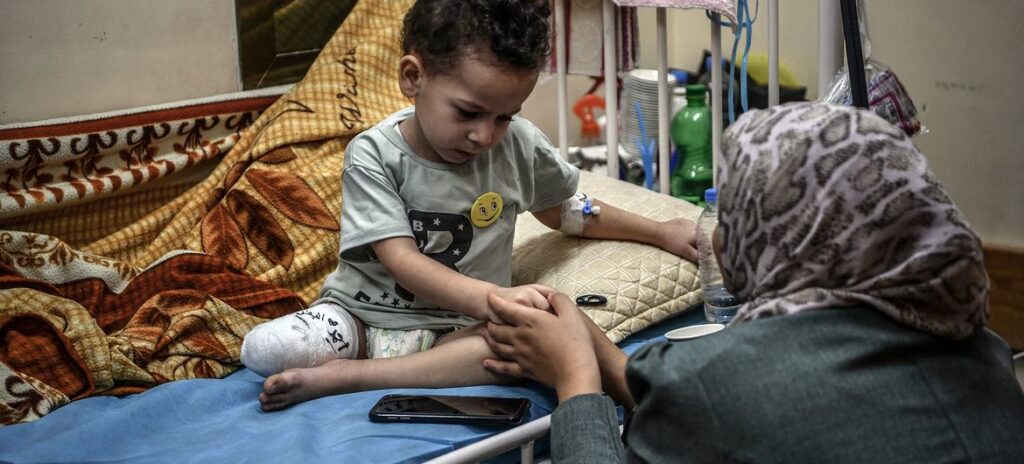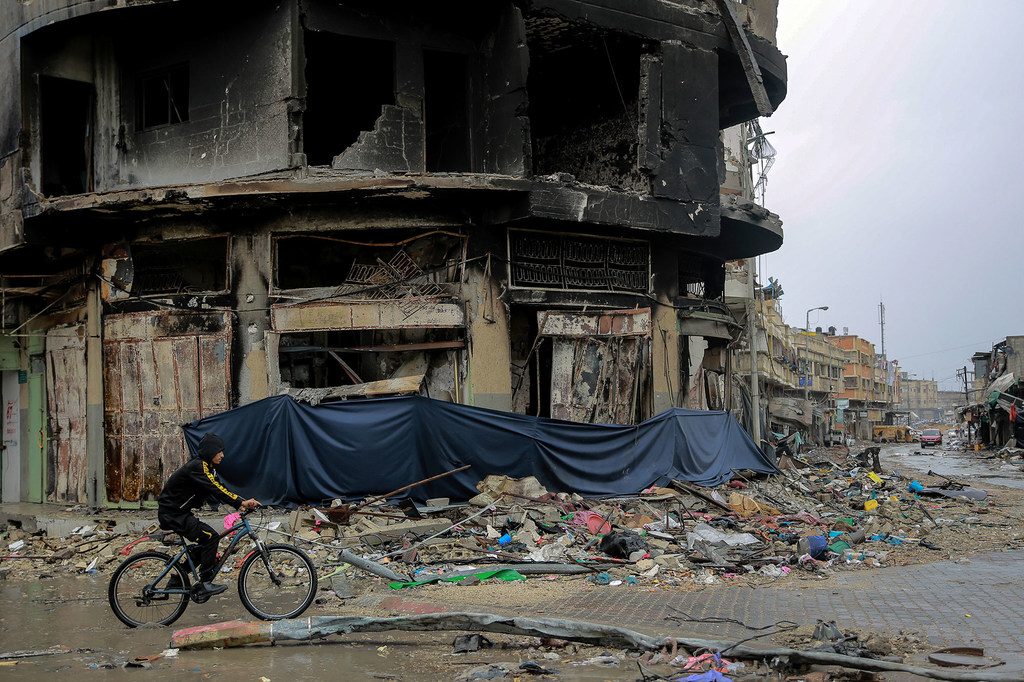Injured Patients ‘Waiting to Die’ in Northern Gaza as Last Hospital Shuts Down, Amid Rising ‘Catastrophic’ Hunger Levels
UNITED NATIONS, 25 Dec 2023
UN News - TRANSCEND Media Service

A 3-year-old boy, whose house was bombed, recovers in Nasser hospital after the amputation of part of his right leg. Gaza, Dec 2023 © UNICEF/Abed Zaqout
21 Dec 2023 – There are no functioning hospitals in the north of Gaza and injured patients who need surgery and cannot be moved are “waiting to die”, the UN health agency said today, in a plea for a ceasefire to allow more aid into the shattered enclave.
The latest grave assessment from the World Health Organization (WHO) came after UN teams reached Al Ahli Arab hospital and Al Shifa hospital on Wednesday, amid reports of intensifying ground operations by Israeli Defense Forces and continuing airstrikes in the Gaza Strip, in response to Hamas’s 7 October terror attacks on southern Israel.
“Patients were crying out in pain, but they were also crying out for us to give them water,” said WHO Emergency Medical Teams coordinator Sean Casey, describing the scene at Al Ahli Arab hospital, where medical staff were struggling to cope with “no food, no fuel, no water”.
“It looks more like a hospice now than a hospital. But a hospice implies a level of care that the doctors and nurses are unable to provide…. It’s pretty unbearable to see somebody with casts on multiple limbs, external fixator on multiple limbs, without drinking water and almost no IV fluids available.
“At the moment, it’s a place where people are waiting to die unless we are able to move them to a safer location where they can receive care.”
Guterres aid call
Highlighting the need to relieve the deteriorating humanitarian crisis in Gaza, UN Secretary-General António Guterres on Thursday said that “intense fighting, lack of electricity, limited fuel and disrupted telecommunications” had severely restricted the UN’s efforts to provide life-saving aid to people in the enclave.
“Conditions to allow for large-scale humanitarian operations need to be re-established immediately,” the UN chief insisted in a tweet.

A boy cycles through the heavily bombarded Asqola neighbourhood of Gaza City, Dec 2023
© UNICEF/Omar Al-Qattaa
Growing hunger
The high-risk mission to northern Gaza involving the WHO, the UN aid coordination office, OCHA, the UN Mine Action Service (UNMAS) and the UN Department of Safety and Security (UNDSS) ensured the delivery of seven pallets of urgently needed medicines, intravenous fluids and supplies for surgery and to treat the wounded, along with equipment to support women giving birth.
Important though the delivery of medical supplies to the north is to provide some relief to patients, much more worrying is the growing and already widespread shortage of food and water.
REPORT: The entire population of #Gaza is experiencing crisis levels of hunger.
Around 26% of Gazans have exhausted their food supplies and coping capacities.
Without access to adequate food, clean water, health and sanitation, families face catastrophic hunger and starvation.
— World Food Programme (@WFP) December 21, 2023
“We are behind. There is not enough food, every single person I speak to everywhere I go in Gaza is hungry,” Mr. Casey said, speaking to journalists in Geneva. “The time is now. We are dealing with starving people now, adults, children, it’s unbearable. Everywhere we go, people are asking us for food even in the hospital, I walked around in the emergency department, somebody with an open bleeding wound, an open fracture; they asked for food. If that’s not an indicator of the desperation, I don’t know what is.”
Famine risk intensifies amid ‘catastrophic’ hunger: WFP
More than one in four households in Gaza are enduring “catastrophic” hunger, according to a new food security report published on Thursday by humanitarians, including the UN World Food Programme (WFP).
Data from the Integrated Food Security Phase Classification (IPC) report confirms that there is a risk of famine in the devastated enclave, unless access to adequate food, clean water, health and sanitation services is restored.
The IPC platform analyses data to determine the severity and magnitude of hunger crises, according to internationally-recognized scientific standards.
This figures show the entire population of Gaza – roughly 2.2 million people – is living with crisis or worse levels of acute food insecurity.
It highlights that just over a quarter (26 percent) of Gazans (576,600 people) have exhausted their supplies and coping capacities and now face catastrophic hunger (IPC Phase 5) and starvation.
“WFP has warned of this coming catastrophe for weeks. Tragically, without the safe, consistent access we have been calling for, the situation is desperate, and no one in Gaza is safe from starvation.” said Executive Director Cindy McCain.
According to the IPC, there is a risk of famine occurring within the next six months if the current situation of intense conflict and restricted humanitarian access persists.
“These are not just numbers – there are individual children, women and men behind these alarming statistics,” said WFP Chief Economist Arif Husain. “The complexity, magnitude and speed that this crisis has unfolded is unprecedented.”
Crippling shortages
According to the UN health agency, only nine out of 36 health facilities in Gaza are partially functional; all of them are located in the south.
“There are no operating theatres (in the north) anymore due to the lack of fuel, power, medical supplies and health workers, including surgeons and other specialists,” said Dr Richard Peeperkorn, WHO Representative and now acting UN humanitarian coordinator in the Occupied Palestinian Territory, speaking from Jerusalem.
At Al Ahli Arab hospital approximately 10 staff – “all junior doctors and nurses” – have continued to provide basic first aid to some 80 patients now sheltering in a church within the hospital grounds, Dr. Peeperkorn explained. “Some of them are severely injured and have been waiting for surgery for two weeks or have been operated on but are now at risk of post-operation infection due to lack of antibiotics and other drugs. All these patients cannot move and need to be transferred urgently, to have a chance to survive.”
Heavy bombing and clashes
According to the UN aid office OCHA’s latest update on the crisis, “heavy Israeli bombardments from air, land and sea”, continued across Gaza on Wednesday.
The most intense shelling was reported in Beit Lahiya and multiple areas in Gaza city (north), eastern Khan Younis in the south and the eastern and western areas of Rafah city, also in the south.
OCHA also reported “intense ground operations” and continuing clashes between Israeli forces and Palestinian armed groups in northern Gaza, Gaza City, the Middle Area, and Khan Younis, along with the firing of rockets by Palestinian armed groups into Israel.
Latest casualty figures from Gaza’s health authorities from Tuesday shared by OCHA indicated that 19,667 Palestinians have killed in Gaza since 7 October, about 70 per cent are believed to be women and children. More than 52,586 people have been injured, according to the same source, which reported that many more were missing, likely buried under the rubble.
The UN update also noted that two Israeli soldiers were reported killed in Gaza between 19 and 20 December. “Since the start of the ground operations, 134 soldiers have been killed in Gaza, and 740 soldiers have been injured, according to the Israeli military,” OCHA said.
New evacuation order
The update also flagged a 20 December immediate evacuation order from the Israeli military covering about 20 per cent of central and south of Khan Younis city. The area was marked in an online map published on social media. Before the 7 October escalation, the area was home to nearly 111,542 people, according to OCHA, which noted that it also included 32 shelters housing about 141,451 internally displaced persons – the vast majority having been previously displaced from the north.
Tags: Antonio Guterres, Gaza, Genocide, Israel, Massacre, Palestine, United Nations
DISCLAIMER: The statements, views and opinions expressed in pieces republished here are solely those of the authors and do not necessarily represent those of TMS. In accordance with title 17 U.S.C. section 107, this material is distributed without profit to those who have expressed a prior interest in receiving the included information for research and educational purposes. TMS has no affiliation whatsoever with the originator of this article nor is TMS endorsed or sponsored by the originator. “GO TO ORIGINAL” links are provided as a convenience to our readers and allow for verification of authenticity. However, as originating pages are often updated by their originating host sites, the versions posted may not match the versions our readers view when clicking the “GO TO ORIGINAL” links. This site contains copyrighted material the use of which has not always been specifically authorized by the copyright owner. We are making such material available in our efforts to advance understanding of environmental, political, human rights, economic, democracy, scientific, and social justice issues, etc. We believe this constitutes a ‘fair use’ of any such copyrighted material as provided for in section 107 of the US Copyright Law. In accordance with Title 17 U.S.C. Section 107, the material on this site is distributed without profit to those who have expressed a prior interest in receiving the included information for research and educational purposes. For more information go to: http://www.law.cornell.edu/uscode/17/107.shtml. If you wish to use copyrighted material from this site for purposes of your own that go beyond ‘fair use’, you must obtain permission from the copyright owner.